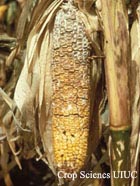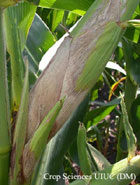Diplodia Ear Rot


Symptoms
- Husks appear either bleached or straw colored
- Infection most often begins at the base of the ear
- The ear may become bleached and brown, but may show no external symptoms
- Coarse, white or grayish brown fungal mycelium develops on the husk or kernels
- The ear may turn brown and become shrunken, rotten, and light
- Late in the season, black specks (fungal fruiting bodies) may be produced on ears
Pathogen Involved
- Stenocarpella (Diplodia) maydis (a fungus)
- This pathogen overwinters on infested corn debris from the previous year
Time of Occurrence
- This disease occurs after flowering
Conditions Favoring Disease
- Corn ears are most vulnerable for three weeks after silking
- Warm and wet weather conditions after silking
- Corn ears that have been damaged by insects or birds
- Conservation tillage
- Corn on corn rotation
Disease Management
- Corn hybrids differ in susceptibility, but resistant corn hybrids not reported
- Crop rotation
- Fall tillage of corn residue